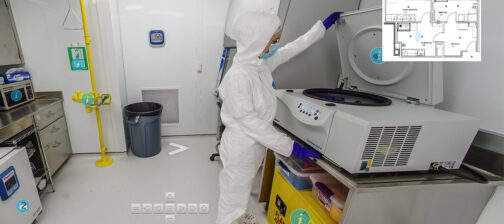This past week, Directors of Collection and Archaeology, Michael Lavin and David Givens, transported skeletal remains for ancient DNA (aDNA) testing to Dr. Deborah Bolnick’s Ancient DNA Lab at the University of Connecticut. There Dr. Raquel Fleskes sampled the petrous bone in the clean room using minimally invasive techniques. This part of the cranium is highly valuable in aDNA research because it does not remodel nearly as much as other bones and it contains the highest concentration of DNA in the human skeleton (Konotopoulos et al. 2019). Additionally, advances in extraction protocols have increased aDNA yields prior to sequencing: “While petrous bone is just one of several substrates, including tooth cementum and hair, demonstrated to be superior for DNA preservation, human petrous bones have yielded up to 183-fold more DNA than any other skeletal element tested (rib, tooth, or long bone) and have been shown to perform better overall than tooth cementum. A subsequent study of various regions within the petrous bone determined that the DNA-dense osseous labyrinth (“inner ear”) yields up to 64-fold more endogenous DNA than the cortical bone encircling it, up to 177-fold more than trabecular bone from the apex of the petrous bone, and up to 410-fold more than a corresponding metatarsal bone” (Sirak et al. 2017).

It took over four hours for Dr. Fleskes to prep and carefully remove the sample from the osseous labyrinth area of the petrous for two individuals. This work is done by using a small diamond encrusted drill bit on the underside of the cranium to create a small depression in the temporal bone to access the petrous. Then an even smaller bit is used to drill the petrous to create bone powder which contains the endogenous aDNA, or the DNA authentic to the skeletal individual. Dr. Fleskes removed around 0.15 grams of petrous bone powder, which will be used to extract and sequence DNA from in the coming weeks. This rapidly advancing science provides new fields of research that adds our understanding of the individuals and communities that formed our nation. Though this is just the beginning of the journey, it takes months, even years, for the large team of experts to collect and consolidate all explored avenues of research. Osteology, macro-botanicals, GPR, soils analysis, aDNA, isotopic signatures, and historical and genealogical research are just a few of the disciplines employed to tell a more complete story of these historic individuals.
Jamestown Rediscovery is a public archaeology program that shares the research journey with visitors on-site at the archaeological dig, in our museum, publications, and online. Jamestown seeks out researchers for this work that believe in this open collaborative partnership. The application of science has the ability to advance our founding narrative. Familial relationships, admixture, and relatedness to descendant communities are just a few of the possibilities through this important work.






